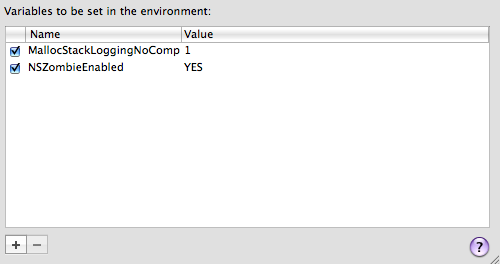This procedure has saved me more than once, so I need to document it throughly for everyone! There are cases where I see messages (in the debugger console) that are like this;
-[NSFetchedResultsController class]: message sent to deallocated instance 0x11957d0
Sometimes, it will talk about “freed” instead of deallocated. That address at the end is important. To track down the line of code where the object was allocated, you’ll need to set a couple environment settings. To do this, right click on the executable you’re trying to debug and select “get info”. Select the “arguments” tag and set the values shown below;

debug environment settings
(be sure to disable these when you’re done. They should not be enabled for a production build!)
Next, run your program and test enough to generate the error. In the Debugger Console, copy that hex address value, then type the command;
(gdb) info malloc-history <paste-address-here>
You should see something like this;
Stack – pthread: 0xa0416720 number of frames: 28
0: 0x9264382d in malloc_zone_calloc
1: 0x92643782 in calloc
2: 0x93611618 in _internal_class_createInstanceFromZone
3: 0x9361ab08 in _internal_class_createInstance
4: 0x3020275c in +[NSObject allocWithZone:]
5: 0x3020264a in +[NSObject alloc]
6: 0x3d92 in -[AMRAPViewController fetchedResultsController] at /Users/dkavanagh/CrossFit Timer/Classes/AMRAPViewController.m:146
7: 0x3a18 in -[AMRAPViewController viewWillAppear:] at /Users/dkavanagh/CrossFit Timer/Classes/AMRAPViewController.m:96
8: 0x3097c945 in -[UINavigationController _startTransition:fromViewController:toViewController:]
9: 0x30977c33 in -[UINavigationController _startDeferredTransitionIfNeeded]
10: 0x3097d01e in -[UINavigationController pushViewController:transition:forceImmediate:]
The first line below the object alloc (in my case, line 6) will show where the offending object was allocated and should really help in tracking down the free/dealloc problem.
The original solution was posted in the app dev forums. You’ll need a login to see this.

